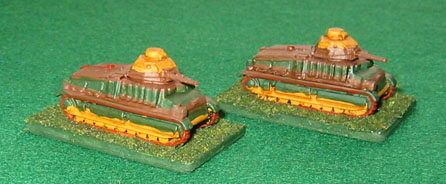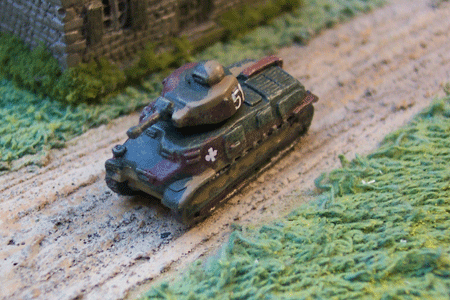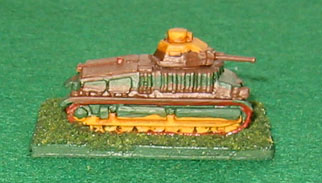|
SOMUA S 35DescriptionThe SOMUA S 35 entered service with the French army in 1936 and was generally regarded as one of the best medium tanks in the world in 1940.
DevelopmentThe S 35 originated in the 1931 requirement from the French High Command which called for an Automitrailleuse de Cavalerie (self-propelled machinegun for the cavalry) weighing 9 tons, having 20mm of armour, a 47mm gun, speed of 30 km/h and range of some 200 km. In 1934 the requirement was revised, calling was for a 13 ton tank with 40mm of armour, and either a 25mm or 47mm gun and a machinegun. In May the same year, SOMUA presented a design, work on a prototype started in November and trials started in the spring of 1935. In 1940 an improved model, the S 40, with a modified suspension and a 220 hp engine was started, but few had been completed by the fall of France.
ConstructionThe S 35 was the world's first tank to be manufactured from a cast steel. The hull was made from cast steel constructed in 3 castings which were bolted together; the hull floor, the front superstructure (covering the fighting compartment and supporting the turret), and the rear superstructure (covering the engine). One fault that was discovered during combat was that the upper and lower hull halves were joined by a ring of bolts, if an anti-tank round hit the seam it could split apart the hull.
OperationThe turret was a variant of the APX 1 used on the Char B1; the APX 1 CE (chemin élargi) with a larger (113 cm instead of 102 cm) turret ring. The radio operator was intended to control the two radios and unlike most other French tanks also assisted the commander in loading the gun. The commander was very overworked in what was effectivly a one-and-a-half-man turret. Apart from directing the driver and keeping in touch with other tanks in his unit (by flags) the commander was also the main gunner. So in action he would have his head in the cupola directing the driver, he would then have to spot the target and jump down into the turret when he would rotate the turret onto the target, peer through the gun-sight and set the range, finally fire the gun. The turret had a cupola where most other tanks would have a turret hatch. The commander could not raise his head out of the turret and thus had a more restricted view than was possible for German tank commanders who often when into battle so. When captured and used by the German Army the cupola was modified by cutting away the top and installing a two-door hatch. This gave the commander much improved visibility. The commander's life in the S 35 was easier than in the two-man light tanks because he at least had a radio operator to help him load the gun and communicate with other commands. Although the commander still needed to rotate the turret this was now done electrically instead of manually. The driver sat on the right and the radio operator next to him on the left. He had a hatch in front of him which was usually left open when the tank moved behind the lines but which would have been suicidal to have open in combat when he relied on an observation slit and a episcope which necessitated detailed instructions from the commander. The driver's job was made easier by the differential steering (like on the B1bis) which allowed the tracks to go in different directions and thus the tank could turn on the spot. This technology was very advanced for it's day and for example not available on German tanks such as the Tiger untill much later in the war. RadioIt was planned in 1925 to equip all tanks with ER 28 radios (range 2km) but because of shortages this was not carried out. Only command tanks were equipped with radios, which allowed them to be easily picked out by the enemy. The platoon commander had an ER 29 mle 1939 radio (range 5km). The squadron commander had both an ER 29 mle 1939 radio (range 5km) and an ER 26 ter radio set (range 60km, 30km when moving). Another problem was that the platoon commanders' radios operated on a different frequency from those of the support troops (the "dragons portés" and the artillery). As standard there was no intercom in the tank which complicated the communications between the commander and his crew. However a few crews seem to have installed on their own initiative. DeploymentThe S 35 tanks equipped the cavalry's four Light Mechanised Divisions (DLM) - 96 tanks per division together with 86 Hotchkiss H 35. 10th May 1940When the Germans's attacked the French army had the following 288 S-35 tanks on active service.
During the fighting the following tanks were added.
Technical Data
| ||||||||||||||||||||||||||||||||||||||||||||||||||||||||||||||||||||||||||||





